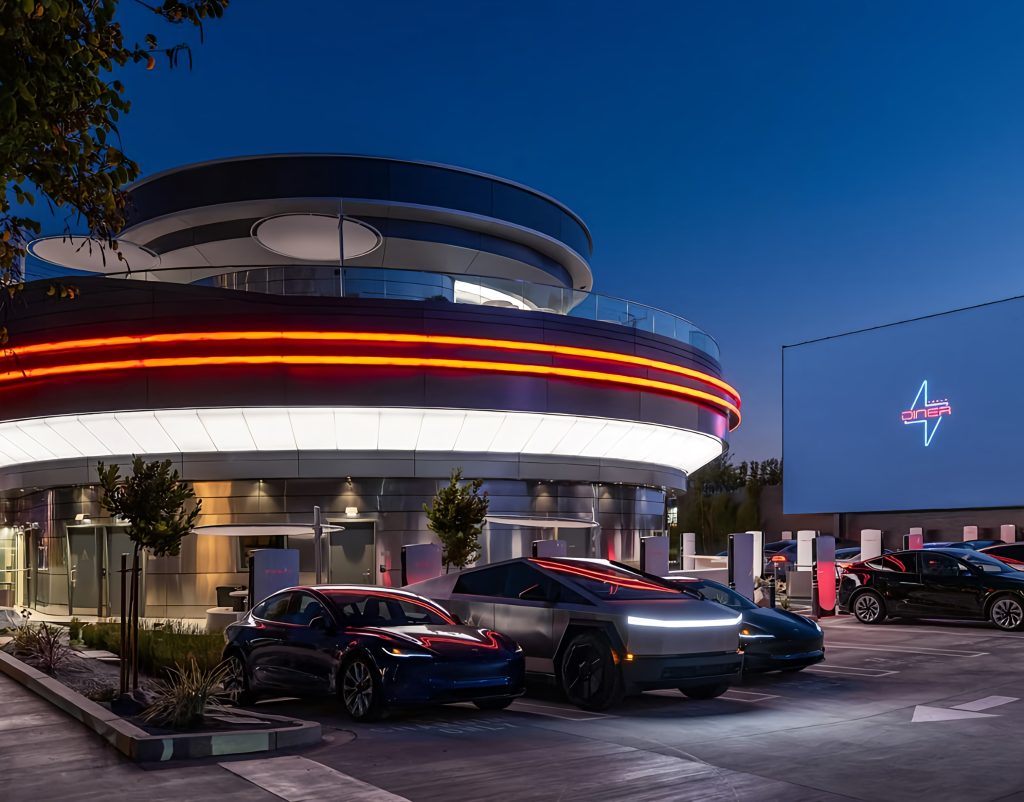
On July 20, Tesla’s first-ever “Supercharger Diner” officially began trial operations in Los Angeles, featuring a Hollywood-themed restaurant and Supercharger station. The highlight of the facility is its integration of two 45-foot LED cinema screens, effectively combining film entertainment with electric vehicle infrastructure.
The Tesla Supercharger Diner is equipped with 80 V4 Supercharger stalls. The audio from the movies and videos shown on the LED displays can be synchronized with the in-car speakers of Tesla vehicles. Additionally, customers can order food directly from their car screens, with a menu that includes classic fast food options such as burgers, fries, chicken wings, hot dogs, milkshakes, and sandwiches.
The concept of this diner was first envisioned by Tesla CEO Elon Musk in 2018. Inspired by 1950s American drive-in restaurants, the design incorporates retro elements such as large-format movie screens, roller-skating waitstaff, and a classic menu. Notably, Tesla’s humanoid robot “Optimus” is also deployed on site to serve popcorn to guests.
As an emerging projection technology, LED cinema display has rapidly expanded beyond traditional theaters in recent years, finding application in broader settings—such as Tesla’s charging diner.
Traditionally, EV charging stations serve primarily as locations for recharging vehicles en route. Tesla, however, has transformed the experience by incorporating LED cinema displays, creating a multi-functional destination that combines charging, dining, and entertainment. This allows Tesla owners to enjoy movies and videos while waiting for their cars to charge, making the downtime more enjoyable.
The broader adoption of LED cinema display beyond conventional theaters is driven by several factors.
Technically, the rapid maturation of LED technology and the continual decrease in costs have been key enablers. LED cinema display offer superior brightness, contrast, and color accuracy, allowing for sharp image quality. Their high refresh rates and low latency also ensure smooth playback for fast-paced content like video games and live sports.
For instance, the 2025 League of Legends MSI Finals was live-streamed in a VLED LED cinema, due to the advantages of LED display in brightness, contrast, and viewing angles, which enhance the visibility of in-game details and dynamic scenes.
Another breakthrough is in acoustically transparent LED display, which address the previous limitation of LED display being unable to transmit sound. Companies such as China Film Group, Lopu, and Unilumin have introduced fully acoustically transparent LED products, allowing audiences to enjoy an immersive experience that integrates visuals with high-quality audio.
Looking ahead, the market potential for LED cinema display is substantial. According to TrendForce, there are over 200,000 cinema screens globally, of which more than 30,000 are considered high-end. These high-end screens are likely to be replaced by LED cinema displays in the future. Moreover, LED displays are expected to be adopted in increasingly diverse scenarios beyond traditional cinemas.
(Photo credit: Tesla)
TrendForce 2025 Global LED Video Wall Market Outlook and Price Cost Analysis
Release Date: 30 September 2024
Language: Traditional Chinese / English
Format: PDF
Page: 302
|
If you would like to know more details , please contact:
|












